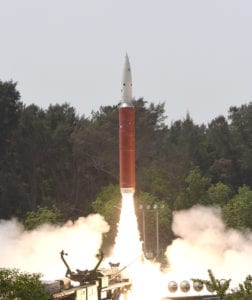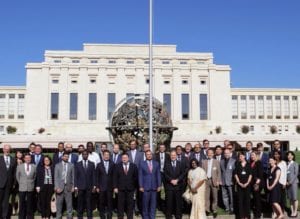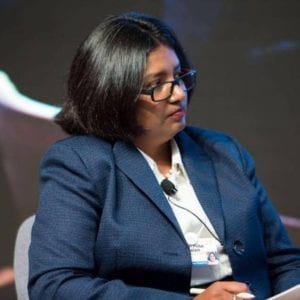SpaceWatch.Global asked its staff and contributors to review 2019 and provide an outlook into 2020. These personal reviews are being published during the holiday season. This is Dr. Rajeswari Pillai Rajagopalan of Observer Research Foundation.
by Dr. Rajeswari Pillai Rajagopalan

This has been an exciting year for me in a number of ways but also an increasingly worrying one, especially when we consider the growing threats to peace and the difficulties in getting the world’s nations to deal with them cooperatively. Developments in the space domain and in the broader strategic realm have kept me engaged through the year. The latter provided the setting, in many ways, for many of the developments in the former, but has also been important by itself.
The developments in the broader strategic setting essentially refers to developments in the Indo-Pacific region, especially politics between the US, China, Japan and India. The region is also home to some of the fastest growing economies, which has translated to acquisition of major hard power capabilities. Competition with China has continued to tick upwards. Sino-Indian competition, in particular, is picking up. Two rounds of informal summits have not been helpful in mitigating the competition and tension in the relationship. China’s growing influence and penetration in southern Asia and Indian Ocean has led to a pushback, including the quadrilateral (Quad) arrangement, which gained further traction in 2019. Bilateral relations — such as the India-Japan, India-Australia, and India-US — and trilaterals including the India-US-Japan have become stronger for the same reason.

But one of my main focus has been on Sino-Indian competition, which is picking up, including in outer space. The Indian anti-satellite (ASAT) in March 2019 was one consequence, a clear deterrence signal to China, which had already tested its ASAT a decade earlier. The test did raise some concern about debris in outer space. On the flip side, there were fears in India that it would yet again sit on the fence and miss an opportunity to develop a critical defense technology, as it had done in the nuclear arena. The debate on an Indian ASAT had become loud after the first successful Chinese ASAT test in January 2007. There has been consensus among all the different Indian stakeholders – the civilian, scientific and military bureaucracies – on the need to demonstrate India’s capability.
India’s newly-acquired capability has raised many questions but Prime Minister Modi argued that the test was a “defensive” move to protect India’s own space assets. Like India, most countries use space for a number of civilian applications including in areas like agriculture, disaster management, weather forecasting and communication, and there is a strong global interest to preserve outer space as a public good. Now that India has acquired an ASAT capability, New Delhi must take earnest efforts at preventing trends towards space weaponisation.
Another important issue has been the end of the INF Treaty and what it means for global security. The treaty led Washington and Moscow to destroy a total of 2,692 short-, medium-, and intermediate-range missiles by 1991. The treaty was seen as particularly important as it is the only nuclear arms control measure that abolished an entire class of weapons. Important questions have been raised as to whether the end of the INF would have strategic implications in the Indo-Pacific. Many in the US Congress as well as arms control advocates have lamented that walking out of a treaty without an alternative one in place as a recipe for an arms race.
Now that the treaty has ended, Russia could possibly build develop a series of INF-category missiles but the real concerns have been about China. Both the Obama and Trump administrations had accused Russia of violating its INF commitments, one of the reasons for the US to end the treaty. In addition to the Russian breaches, the Trump Administration was particularly worried about the Chinese inventory of around 2,000-odd ballistic and cruise missiles, a significant majority of which would be in violation of the INF if China was a party to the treaty. But now that the shackles of the INF are gone, Beijing argues that Washington could deploy conventional ground-launched missiles in East Asia that could possibly tilt the military balance in the region. This could of course legitimize all of the missiles that China has already deployed, which are threatening to its neighbours as well as the US. There has been talk about a possible multilateral arrangement as a successor to the INF but China has remained categorically opposed to such ideas.

Unfortunately, global governance mechanisms are not keeping up with the increasing threats that international peace and stability are facing. The failure was most evident at the 2018-2019 United Nations Group of Governmental Experts (GGE) on PAROS (Prevention of Arms Race in Outer Space). The failure in developing consensus among great powers has been an issue for more than two decades now. The state of the play within the Conference on Disarmament (CD) is illustrative of this paralysed nature of inter-state relations, especially among the great powers. I was associated with the UN GGE on PAROS as a Technical Advisor to the Group, which deliberated on PAROS over two two-week long sessions but at the end, the divisions within the Group was so stark that it could not agree upon a commonly-agreed upon text to be released as a consensus report.
As the year ends, therefore, it is clear that there is a lot of work to be done if we have to maintain a stable international order. But there is also growing worry that we are running out of time.

Bio: Dr. Rajeswari Pillai Rajagopala is currently a Distinguished Fellow and Head of the Nuclear & Space Policy Initiative at the Observer Research Foundation, New Delhi. She is also the Technical Advisor to a new UN Group of Governmental Experts (GGE) on Prevention of Arms Race in Outer Space (PAROS) (July 2018-July 2019). As the senior Asia defence writer for The Diplomat, she writes a weekly column on Asian strategic issues. She joined ORF after a five-year stint at the National Security Council Secretariat (2003-2007), where she was an Assistant Director. Prior to joining the NSCS, she was Research Officer at the Institute of Defence Studies and Analyses, New Delhi. She was also a Visiting Professor at the Graduate Institute of International Politics, National Chung Hsing University, Taiwan in 2012.





